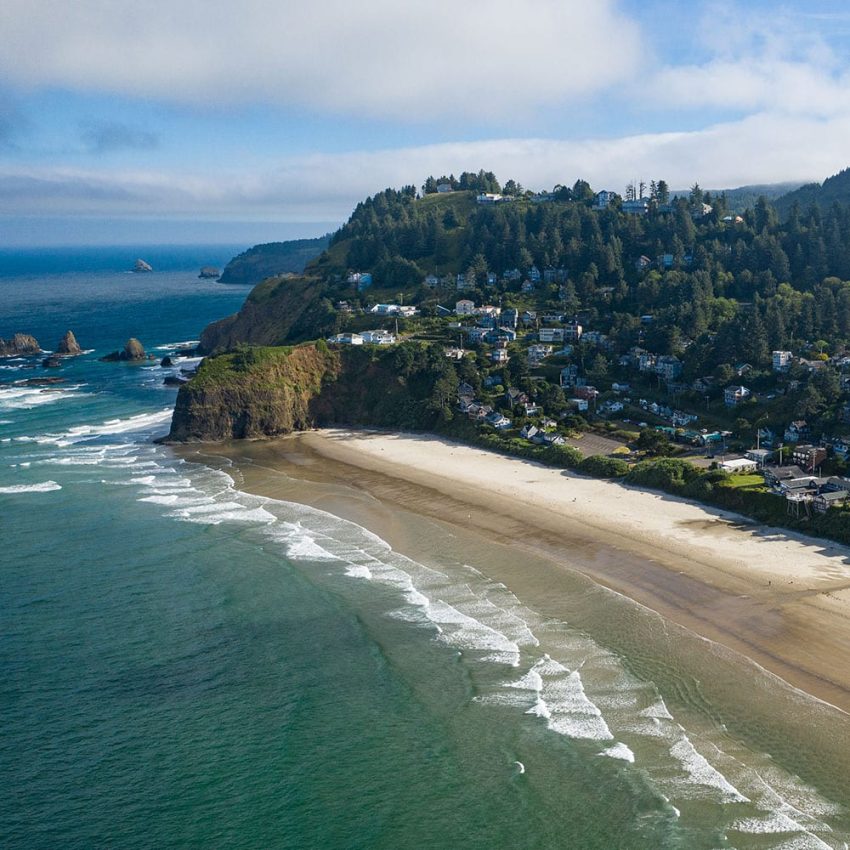By Jerry Keene, Editor, The Oceansider
A long-deferred vision. Over the past three decades, Oceanside has formally submitted three Community Plans to Tillamook County. Beginning with the original community plan in 1998, each of those plans has references surveys that identified our top priority as preserving Oceanside’s “rustic coastal village atmosphere.” To that end, our civic leaders have consistently urged the county to implement Village zoning ordinances consistent with that “vision.” Not once since the 1990s, however, has the county gone beyond politely noting that “vision” and actually entertained practical steps to achieve it by revising our zoning ordinances. Meanwhile, homes have gotten bigger and more out of step with our Village character.
 A rare opportunity. A year ago, a number of factors came together to change that. A state law mandating “middle housing” prompted the county to invite the ONA and its Zoning and Community Plan Review Committee (“ZAPR”) to solicit input and formulate updates to the Oceanside residential zone ordinance. Since then, the committee has met repeatedly in a complex but ultimately productive effort to do so. The result is a list of 9 modest proposals to encourage aesthetic features, proportionate buildings, maximum lot coverages and other measures that are common in other communities. Overall, they lend some structure to Oceanside’s otherwise expansive building standards.
A rare opportunity. A year ago, a number of factors came together to change that. A state law mandating “middle housing” prompted the county to invite the ONA and its Zoning and Community Plan Review Committee (“ZAPR”) to solicit input and formulate updates to the Oceanside residential zone ordinance. Since then, the committee has met repeatedly in a complex but ultimately productive effort to do so. The result is a list of 9 modest proposals to encourage aesthetic features, proportionate buildings, maximum lot coverages and other measures that are common in other communities. Overall, they lend some structure to Oceanside’s otherwise expansive building standards.
This Sunday, May 18, at 2 pm, the ONA will hold a Special Meeting at which each of the ZAPR proposals will be offered to the membership for a vote. Here is the ONA Special Meeting Notice and Zoom Link.
 Cynical opposition. The committee’s recommendations are opposed on a blanket basis by the same group who ran what they themselves described as a “vicious” campaign against the incorporation ballot measure in 2022. They are mostly based in southern Oceanside, safely distanced from the construction excesses faced by those in the Village. This group has simplistically instructed Oceansiders to “just vote no” on every one of the 9 ballot items. They make no effort to debate the pros and cons or offer any competing “vision” for the community. To the contrary, they warn Oceansiders not to be swayed by how benign or reasonable some of the proposals might seem because doing so might provide an opening to actually discuss their merits at the upcoming county hearings. Instead, they are cynically discouraging such reasoned consideration and pointedly ignore the disruptive construction trends in the Village that these measures were proposed to address.
Cynical opposition. The committee’s recommendations are opposed on a blanket basis by the same group who ran what they themselves described as a “vicious” campaign against the incorporation ballot measure in 2022. They are mostly based in southern Oceanside, safely distanced from the construction excesses faced by those in the Village. This group has simplistically instructed Oceansiders to “just vote no” on every one of the 9 ballot items. They make no effort to debate the pros and cons or offer any competing “vision” for the community. To the contrary, they warn Oceansiders not to be swayed by how benign or reasonable some of the proposals might seem because doing so might provide an opening to actually discuss their merits at the upcoming county hearings. Instead, they are cynically discouraging such reasoned consideration and pointedly ignore the disruptive construction trends in the Village that these measures were proposed to address.
 Dangling a red herring. To deflect such reasoned discussion, opponents have fixated on how some undetermined number of houses may become classified as “nonconforming uses” if these proposals ultimately pass. This is an overly ominous land use term that simply refers to existing buildings which are grandfathered under the building rules in effect when they were built. While the proposals may theoretically pose that issue for a marginal number of houses, the fact is that many of the homes in the century-old Village area have been classified as “nonconforming uses” for decades without practical impact. Even so, the ZAPR committee was responsive to this concern. Their proposal includes a request for the county to grant protective exemptions to any such homes – although the county has warned that this might not be legally viable. Either way, the “nonconforming use” aspect is just one factor to weigh against the community benefits of the ZAPR proposals, but not one that merits summarily rejecting them out of hand.
Dangling a red herring. To deflect such reasoned discussion, opponents have fixated on how some undetermined number of houses may become classified as “nonconforming uses” if these proposals ultimately pass. This is an overly ominous land use term that simply refers to existing buildings which are grandfathered under the building rules in effect when they were built. While the proposals may theoretically pose that issue for a marginal number of houses, the fact is that many of the homes in the century-old Village area have been classified as “nonconforming uses” for decades without practical impact. Even so, the ZAPR committee was responsive to this concern. Their proposal includes a request for the county to grant protective exemptions to any such homes – although the county has warned that this might not be legally viable. Either way, the “nonconforming use” aspect is just one factor to weigh against the community benefits of the ZAPR proposals, but not one that merits summarily rejecting them out of hand.
What about the lawyers? In the closing weeks of the committee sessions, county officials abruptly announced that their legal consultants were warning that some of the ZAPR proposals may not be legally viable. Other attorneys disagreed. The ZAPR committee prudently decided to base their decisions on community merit and let the lawyers hash things out at the county hearings. ONA members should follow their example by voting their vision and letting the county work out the technical issues in subsequent proceedings.
Skewed voting results. Finally, there has been a determined effort by some to generate opposition by alarming nonresident property owners who know little about the proposals themselves and have rarely if ever participated in Oceanside’s civic activities. They have every right to participate, but the resulting vote will not be representative of the views of the entire community unless residents also make a special effort to take part.
Regardless of the outcome, this election is a rare opportunity for practical change that all Oceansiders should take part in. Who knows if it will be another 20 years before we have another chance to do so?
jerrykeene@oceansidernews.com


